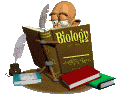| Chapter
Objectives
- Diagram energy flow
through the biosphere
- Describe the overall
summary equation for cellular respiration
- Distinguish between
substrate-level phosphorylation and oxidative phosphorylation
- Explain how exergonic
oxidation of glucose is coupled to endergonic synthesis of
ATP
- Define oxidation and
reduction
- Explain how redox reactions
are involved in energy exchanges
- Define coenzyme and
list those involved in respiration
- Describe the structure
of coenzymes and explain how they function in redox reactions
- Describe the role of
ATP in coupled reactions
- Explain why ATP is required
for the preparatory steps of glycolysis
- Describe how the carbon
skeleton of glucose changes as it proceeds through glycolysis
- Identify where in glycolysis
the sugar association, substrate-level phosphorylation, and
reduction of coenzymes occur
- Write a summary equation
for glycolysis and describe where it occurs in the cell
- Describe where pyruvate
is oxidized to acetyl CoA, what molecules are produced , and
how pyruvate links glycolysis to the Krebs cycle
- Explain at what point
during cellular respiration complete oxidation of glucose
occurs
- Explain how the exergonic
"slide" of electrons down the electron transport
chain is coupled to the endergonic production of ATP by chemiosmosis
- Describe the process
of chemiosmosis
- Explain how membrane
structure is related to membrane function in chemiosmosis
- Describe the fate of
pyruvate in the absence of oxygen
- Explain why fermentation
is necessary
- Distinguish between
aerobic and anaerobic metabolism
- Describe how food molecules
other than glucose can be oxidized to make ATP
- Describe evidence that
the first prokaryotes produced ATP by glycolysis
- Explain how ATP production
is controlled by the cell and what role the allosteric enzyme,
phosphofructokinase, plays in this process
******************
- Distinguish between
autotrophic and heterotrophic nutrition
- Distinguish between
photosynthetic autotrophs and chemosynthetic autotrophs
- Describe the location
and structure of the chloroplast
- Explain how chloroplast
structure relates to its function
- Write a summary equation
for photosynthesis
- Explain van Niel's hypothesis
and describe how it contributed to our current understanding
of photosynthesis
- Explain the role of
REDOX reactions in photosynthesis
- Describe the wavelike
and particle-like behaviors of light
- Explain why the absorption
spectrum for chlorophyll differs from the action spectrum
for photosynthesis
- List the wavelengths
of light that are most effective for photosynthesis
- Explain what happens
when chlorophyll or accessory pigments absorb photons
- List the components
of a photosystem and explain their functions
- Trace electron flow
through photosystems I and II
- compare cyclic and noncyclic
electron flow and explain the relationship between these components
of the light reaction
- Summarize the light
reactions with an equation and describe where they occur
- Describe important differences
in chemiosmosis between oxidative phosphorylation in mitochondria
and photophosphorylation in chloroplasts
- Summarize the carbon-fixing
reactions of the Calvin cycle and describe changes that occur
in the carbon skeleton of the intermediates
- Describe the role of
ATP and NADPH in the Calvin cycle
- Describe what happens
to rubisco when the O2 concentration is much higher than
CO2
- Describe the major consequences
of photorespiration
- Describe two important
photosynthetic adaptations that minimize photorespiration
- Describe the fate of
photosynthetic products
|
| Chapter
Terms:
| Chapter
9 |
| fermentation
cellular respiration
redox reactions oxidation
reduction
reducing agent
oxidizing agent
NAD+ |
glycolysis
Krebs cycle
oxidative phosphorylation
substrate-level phosphorylation
acetyl CoA
cytochrome (cyt)
ATP synthase |
chemiosmosis
proton-motive force
aerobic
anaerobic
alcohol fermentation
lactic acid fermentation
facultative anaerobe |
| |
| photosynthesis
autotrophs
heterotrophs
chlorophyll
mesophyll
stomata
stroma
light reactions
Calvin cycle
NADP+
photophosphorylation
|
visible
light
photons
absorption spectrum
chlorophyll a
action spectrum
chlorophyll b
carotenoids
reaction center
primary electron acceptor
photosystem I
photosystem II
|
cyclic
photophosphorylation
cyclic electron flow
cyclic photophosphorylation
rubisco
C3 plants
photorespiration
C4 plants
bundle-sheath cells
mesophyll cells
PEP carboxylase
CAM plants |
|
| Chapter
Outline Framework
- Principles of
Energy Conservation
- Cellular respiration
and fermentation are catabolic (energy-yielding) pathways
- Cells must recycle
the ATP they use for work
- Redox reactions release
energy when electrons move closer to electronegative atoms
- Electrons "fall"
from organic molecules to oxygen during cellular respiration
- The "fall"
of electrons during respiration is stepwise, via NAD+ and
an electron transport chain
- The Process of
Cellular Respiration
- Respiration involves
glycolysis, the Krebs cycle, and electron transport
- Glycolysis harvests
chemical energy by oxidizing glucose to pyruvate
- The Krebs cycle completes
the energy-yielding oxidation of organic molecules
- The inner mitochondrial
membrane couples electron transport to ATP synthesis
- Cellular respiration
generates many ATP molecules for each sugar molecule it oxidizes
- Related Metabolic
Processes
- Fermentation enables
some cells to produce ATP without the help of oxygen
- Glycolysis and the
Krebs cycle connect to many other metabolic pathways
- Feedback mechanisms
control cellular respiration
- Photosynthesis
in Nature
- Plants and other autotrophs
are the producers of the biosphere
- Chloroplasts are the
sites of photosynthesis in plants
- The Pathways
of Photosynthesis
- Evidence that chloroplasts
split water molecules enabled researchers to track atoms
thorough photosynthesis
- The light reactions
and Calvin cycle cooperate in converting light energy to
the chemical energy of food
- The light reactions
transform solar energy to the chemical energy of ATP and
NADPH
- The Calvin cycle uses
ATP and NADPH to convert CO2 to sugar
- Alternative mechanisms
of carbon fixation have evolved in hot, arid climates
- Photosynthesis is
the biosphere's metabolic foundation
back
to top |
|

